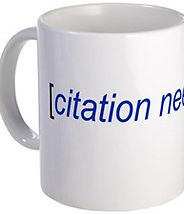Medducation: Language, Literature & Life

In-Text Citations:
This term describes the steps you take to show your reader exactly where your paraphrased and directly quoted information actually came from.
Like all MLA (Modern Language Association) citations, one of the best places to learn about in-text citations is on the Purdue OWL site: Click here to read more!
In-text citations are often confused with the information normally listed in a Works Cited page at the end of an essay. This is not the same thing at all. The info in the Works Cited includes all of the important details about each source of evidence you used in your writing or presentation.
A proper in-text citation tends to "use information from another source to help prove" (Medd 13) that it is reliable and that it came "from a real source" (15). The last sentence included two in-text citations in brackets that immediately follow the information quoted or paraphrased. The first bracket indicates the author's last name and the page number the quoted information was found on. The second citation bracket includes only the page number, as this info also came from the same text published by Ben Medd. Since we have already noted that Medd was the author in the first citation bracket, we don't need to add the 'Medd' again in the same piece of writing.
If you are using information that is paraphrased (not directly quoted in a word-for-word style), you still need to show where your summarized information came from (13, 21-22, 452). In this last sentence, for instance, the citation bracket is suggesting the information in the sentence was based on evidence found on pages 13, 21-22, and 452 of the same text that was authored by Ben Medd.
MLA Style - How to 'Show Your Work' in English Writing
The Modern Language Association (MLA) is the system that we typically use for all work in English courses. Think of this system as a road map for your reader to easily find all of the great information you've pulled together to form your argument. Without this roadmap to facts, ideas, quotations and evidence, your readers have no way of knowing whether you have a good, logical and persuasive argument. They just know you have an opinion. And while it's important to have an opinion, only well-supported arguments survive the process of marking.
There are all kinds of great (and even more terrible) online resources for understanding how to use MLA style. The best one (according to this course) is the resources provided by the Purdue University OWL site. Please click here to visit the OWL for a complete guide to using MLA.
What?!?! The Internet Can Do My Citations and Works Cited For Me???
Yup. Click on the image of the book to visit a
reliable and free online citation generator.
This particular one does both Works Cited
and in-text citations and seems to work fairly reliably.
That being said, you still always need to check and edit
the citations these generators give you.
They are often correct, but there are still issues with spacing, font and format that can weaken your work if you aren't on the ball.
The Completely Correct Citation Corner
- Home of the CCC Cup -
This space is reserved for the best pieces of student writing in each major class assignment. If you manage to perfect the art of using seamlessly integrated quoations and flawless citations to back up your well-argued points, then you will have a place of honour on this wall.
If you don't immediately make it up here,
don't worry. You can always copy. No,
really. I'm being serious here. The best thing
about citations and working with quotations
is that you can actually do this right all the
time just by following the (admittedly boring)
rules. Use the OWL Purdue MLA site, the
citation generator, the info on this site and
look at what other people in the class are
doing (below). This is the one part of
English that has an actual right or wrong answer and it's the one and only place that it's very possible to earn a perfect grade just by following the instructions.

